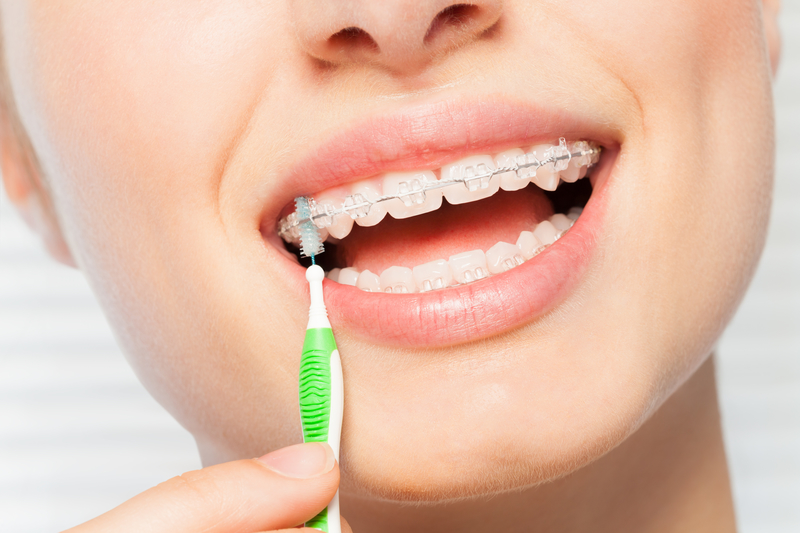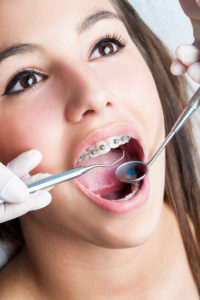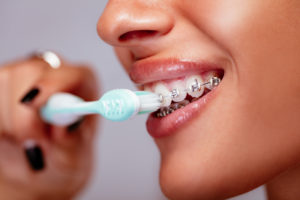Be Thankful for Orthodontic Treatment

Studies show that not enough Americans are taking good care of their teeth, especially through dental and orthodontic treatment. The advanced technology available today is what allows patients to keep their natural teeth healthy for life and is something that millions in the world don’t have access to. Find out why oral health services such as orthodontic treatment is so important to patients and something to be thankful for this time of year!
Your Oral Health
When you think of the most chronic conditions and diseases that plague people today, you may not think of cavities as being one of the them. The National Institutes of Health reports that tooth decay—or cavities—are the most “chronic, prevalent disease” among American children and adults. In fact, about 92% of people have tooth decay by the time they reach adulthood. In all age groups, roughly between 20% and 25% of people have untreated decay they are not aware of.
What does tooth decay have to do with orthodontic treatment? This decay can happen to anyone at anytime and you are more likely to have tooth decay during your orthodontic treatment. Many patients opt for lingual, ceramic or traditional metal braces to straighten their teeth. These methods require brackets that are bonded to the teeth with wires that pass through those brackets. Even though these appliances are highly effective for providing beautiful straightening power, they can make it harder to clean your teeth. Because it’s harder to clean them, and some patients don’t take the extra time to do this, you can end up with tooth decay. That adds to that 92% statistic.
The best way to eliminate your risk for that tooth decay (as well as other oral health diseases), is to properly care for your teeth both with and without braces. That involves brushing your teeth at least twice a day for 2 minutes at a time, as recommended by the American Dental Association. When you have braces, you have to do this after every meal to avoid acidic plaque buildup, which happens when your food and drink sugars mix with mouth bacteria. With braces, threadable floss to go around brackets and wires is generally needed, as well as cleaning items such as a waterpik (water shooter) tool and a proxabrush for brackets. Your oral health can be stellar during orthodontic treatment with the right oral hygiene.

How Does the U.S. Compare?
Orthodontic treatment is a time when those in the U.S. can have a greater risk for developing cavities. This comes from a lack of oral hygiene during your orthodontic treatment period. However, the world at large is battling oral health diseases and poor dental and orthodontic care on an epidemic scale. The World Health Organization reports that cavities (tooth decay) and gum disease (periodontal disease) “have historically been considered the most important global oral health burdens”.
60%-90% of people worldwide have tooth decay and oral diseases connected to this condition. Children are affected the most, but statistics are almost as high in adults worldwide. Even though the U.S. is at a high percentage when it comes to tooth decay (92%), the presence of tooth decay is generally eliminated in most of the population through proper dental work and access to dental services. In the majority of other countries—especially underdeveloped ones—dental or orthodontic work is not a possibility for most. Oral health diseases are simply left untreated or the teeth are pulled when they become too painful.
The Connection to Orthodontic Treatment
Getting a cavity or having an oral health problem during your life can definitely be avoided, but most people will have some sort of oral problem, even if it is small. There are ways to prevent those problems such as proper brushing and flossing every single day. A great way to reduce your risk for oral health diseases is through orthodontic treatment. For children, this is known as child orthodontics. The American Association of Orthodontics recommends that children have their first orthodontic appointment between age 7 or 8.
This is a time when baby teeth are starting to fall out and adult, permanent teeth are starting to come into the mouth. Proper examination by an orthodontist can sport bite and alignment issues that are developing in children. When these issues occur, the teeth can come in crooked all over or they may not rest in the position they are supposed to. This can lead to speech impediments, many dental emergencies and broken teeth in the future from uneven dental pressure, higher instances of tooth decay and gum disease, and problems with oral health diseases.
Orthodontic treatment when young can help align the teeth and jaws to prevent oral problems as a child grows. When teens and adults receive orthodontic treatment via braces, they can better straighten permanent teeth when they come in. This sets everything straight and functional before the jaws harden in adulthood. Straight teeth and aligned jaws make it so cleaning the teeth becomes almost effortless. The risk for tooth decay and gum disease is also significantly lower.

Be Thankful for Your Orthodontic Treatment
Dentistry and orthodontic treatment helps diminish the presence of oral diseases.Yes, tooth decay and gum disease happen frequently due to poor oral hygiene habits. However, orthodontic treatment can help prevent those problems in the first place. Great oral care can prevent developing problems throughout your life. Even when these issues do happen, you won’t have to simply get your teeth pulled or let them decay and fall out of your mouth.
You have great orthodontic and dental options in the United States that allow you to keep your teeth, while many people across the globe have to lose them. Remember that the next time you think about skipping your oral care appointments. To reduce your risk for oral health diseases, you can call Belmar Orthodontics at (303) 225-9016 and ask about your orthodontic treatment plan.
Preventing Cavities During Braces

Braces is an exciting time for getting that straight smile you’ve always wanted. The not-so-exciting part about braces though, is that they give you a greater risk for cavities. Because there are appliances attached to your teeth, they can become havens for bacteria and plaque buildup. Proper oral hygiene, avoiding certain foods can help you prevent cavities during your time with braces!
Your First Orthodontic Appointment
Finding cavities before you get braces is key to ensuring that you have a healthy smile before getting brackets and wires on your teeth. With braces, you will meet often with your orthodontist to have your braces adjusted. However, you still need to go to your dental appointments to make sure you don’t have cavities during braces.
Traditional metal braces, ceramic braces and lingual braces all have brackets and wires that go on your teeth. Before you get fitted for these braces, you will have dental x-rays taken by the dentist to detect cavities. It’s very important to get your exam so tooth decay is detected. Otherwise, you could end up with large cavities during braces. If cavities are found, they must be fixed before we put your braces on.

Oral Hygiene Is a Must
The status of your smile and your oral health will depend on what you do once you get your braces. The American Dental Association recommends brushing your teeth at least twice a day and flossing 1-2 times. That recommendation is for patients who don’t have braces. When you have braces, you have to be extra meticulous with oral hygiene practices and you will have to do them more than you used to. That means, brushing after every single meal if you can.
To avoid cavities during braces:
- Brush your teeth after every meal. Use a soft-bristled toothbrush with fluoride toothpaste, and brush for 2 minutes every time, making sure to go in all different directions to dislodge food.
- Floss your teeth. This is a habit many people skip with braces because it takes a bit more time. However, it’s time well spent. Floss at least twice a day, using threadable floss. This kind of floss allows you to thread it through the spaces between your teeth, pulling it through so you can floss like normal. It makes flossing a breeze and helps prevent cavities during braces.
- Use orthodontic cleaning tools. A waterpik is a great water-spraying tool that can help you dislodge stuck food. A braces brush (that looks like a Christmas tree brush) can get food out of brackets.
- Watch what you eat! More sugar means more cavities during braces. Limit how much sugar you eat. You want to avoid sticky, sugary foods such as taffy, Starbursts, dried fruit, gummies, fruit snacks, caramels, and anything similar.

Developing Cavities During Braces
Sometimes, tooth enamel is simply weak and tooth decay happens, despite all your hard effort to avoid cavities. When you eat, sugars in your food mixes with mouth bacteria to create plaque. That plaque sticks to your teeth and slowly eats it away, creating decay. You only need plaque stuck in the right place to develop cavities during braces. When you have hidden tooth decay, you may start to feel symptoms such as a toothache, tooth sensitivity or pains with hot and cold. When you see these signs, get dental x-rays taken to see if you have cavities during braces.
If there is a cavity, you actually can have it fixed even if you have braces. It all depends on where the decay is. In most cases, cavities during braces can be fixed because many will lie on surfaces not covered with brackets or wires. You would have the decay drilled out and filled as you normally would. However, if you have a band on your teeth or brackets and wires right where decay is, we would have to remove the bracket or wire while you get it fixed at the dental office. We would then have you come back to our office to get your dental appliance reattached. Patients can sometimes develop such severe cavities during braces that they will need root canals. However, if you are taking care of your teeth, you won’t ever have to worry about that.
Best Option to Avoid Cavities
If you are worried about cavities during braces or have seen a family member get cavities during braces, then getting braces might make you nervous. However, no matter what braces option you choose, the benefits of a straight, beautiful smile can last a lifetime. It’s definitely worth it to get braces; you will just have to be careful to take care of them. If cavities during braces are a concern, consider the benefits of using Invisalign aligners. This is one of our most popular orthodontic options for teens and adults because it is a hidden option for straightening your teeth.
Invisalign transparent aligners are a series of custom-made aligners (like retainers) that fit incredibly snug to your teeth. We take digital calculations of your mouth, where we then design transparent aligners around the shape of your teeth and where we want them to be 18-24 months from that time. Each week, you will switch to a new aligner, which will slowly put pressure on different areas of your mouth, shaping the teeth into a straight line. The aligners are clear and designed to be virtually unnoticeable on your teeth.
When it comes to cavities during braces, you are the one that decides if you will get them with this orthodontic option. That’s because that are completely removable for eating, drinking, flossing and brushing your teeth. It takes less time to brush and floss because of this and there are no appliances on your teeth. This can reduce your risk for cavities during braces, especially if you already know that you have weak tooth enamel. For any questions about cavities during braces, call Belmar Orthodontics at (303) 225-9016!
Oral Health Facts for Children and Adults

Did you know that what you eat makes a major difference in how healthy your mouth is? What you eat can determine your likelihood for tooth decay and other oral health diseases. Did you know that your teeth also aren’t bones like many people think? They are made of an entirely different substance even though they are hard like bones. Find out oral health myths and facts that exist, how to care for your teeth properly, and some facts about orthodontic care!
Are Your Teeth Bones?
Many people think the teeth are bones, but they aren’t. They are hard like bone, but are actually harder. Teeth are the hardest substance in your body, as they are made up of about 96% mineral. Bones have a more sponge-like interior and aren’t solid mineral. However, your teeth and bones are made of similar materials such as calcium and phosphate, which is why they are both so hard.
Facts About Your Teeth
Infant and adult teeth are not the same:
- Infants are not born with their teeth. Most start to get teeth between 3 and 9 months of age.
- Children can receive their teeth up until age 3. Some will get all their teeth within a few months, whereas others get them slowly one-by-one.
- Children only have 20 baby teeth compared to an adult’s 32.
- As soon as a child gets a first tooth, it needs to be brushed at least twice a day. Infants also need to see the dentist within 6 months of getting their first tooth.
- Bite and alignment problems in children are best treated around ages 7 and 8. This is the recommended time for children to visit an orthodontist. If bite and alignment problems are present, child braces can correct the problems before they become severe later on.
- Children get their teeth in a certain order: the bottom front 2 teeth, followed by the top 2 teeth. Then, the next tooth on either side on the bottom jaw, then the next two on either side on the top jaw, etc.
- Children lose their teeth in the order that they came into the mouth. Losing the baby teeth makes way for the adult teeth to start coming in once a child has grown larger.
- Adults will have 32 total teeth. Most will have the 4 wisdom teeth taken out, which drops that total number down to 28.

Brushing and Flossing
Many people brush their teeth but don’t see the importance of flossing. Plaque doesn’t go away unless you physically remove it with brushing and flossing. Only brushing your teeth is like only cleaning the outside of a car and never the inside. The inside parts can fill up with gunk, just like the spaces between your teeth. Flossing is especially important during your time with braces. Not flossing could land you with cavities or cratered parts of your teeth when braces come off.
Avoiding the Dentist or Orthodontist
“The dentist/orthodontist is scary”. Although many think the dentist is scary, it’s not actually. Some people fear going to the dentist, even though the dentist is someone who is only interested in helping you be healthier. Going to the actual dental office can evoke negative feelings if you’ve had a bad experience. This is why sedation dentistry was created. This is a form of dentistry where you can receive sedation during your procedure to help make it a more positive experience. If you think the dentist (or the orthodontist) is scary, we can help it be less scary. That’s especially because an orthodontist won’t have needles and drills at your appointment. They either put your braces on or tighten them for you. Not so scary, right?
Myths About Orthodontic Care
There are many myths about orthodontic care that could hurt you if you’re not careful. You want to always seek out the best care for your teeth and receive that care from a trained professional.
- Providers who offer orthodontic treatment are orthodontists: false. Now, more than ever, there are many dentists or oral health professionals that are starting to offer orthodontic treatment. Many offer this treatment in the form of Invisalign aligners. This is a great system for straightening the teeth, but only if you have the right training. Orthodontists are specifically trained to straighten your teeth correctly. Dentists are not unless they have specifically received schooling and training in orthodontics. Check credentials before you let someone touch your teeth.
- Braces are too expensive: false. Braces aren’t the cheapest purchase in the world, but they can benefit you more than most other things you’ll ever invest in. Many insurance plans work with patients to make braces affordable, and we do the same. We want as many people as possible to receive orthodontic care. If you think they are too expensive, give our office a call and we will work with your budget. Any person can receive great orthodontic treatment if they work closely with an orthodontist.
- Braces are only for children: false. Studies show that at least ¼ of people that wear braces (so about 1 million+ each year) are adults. Almost half of the people wearing braces are teens. So no, braces are not just for children. Adults also have several virtually-invisible options for orthodontic care such as transparent aligners and lingual braces. These options make braces a great choice for adults.

Great Oral Health
No matter the myths or facts you’ve heard about your oral health, the bottom line is that it’s important! How well you take care of your teeth will determine how good your health is and how much confidence you have in yourself. Studies show that people with straighter, more beautiful smiles are happier, healthier and more confident. You can have that confidence to no matter if you are young or old. To learn more about braces and proper oral hygiene while having them, call Belmar Orthodontics today at (303) 223-9016!

